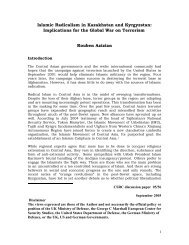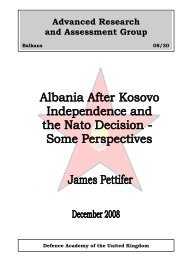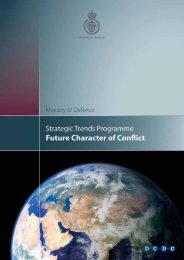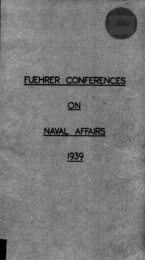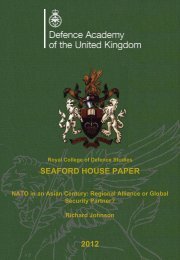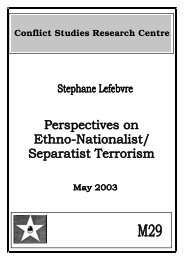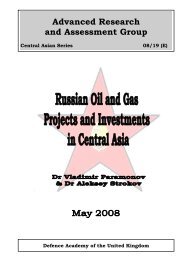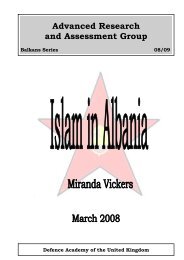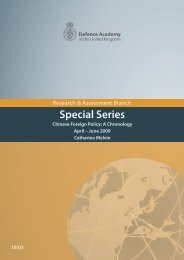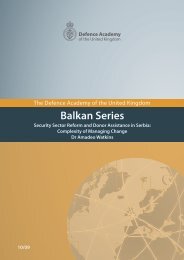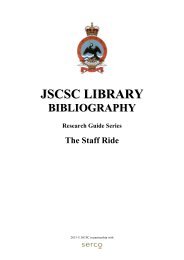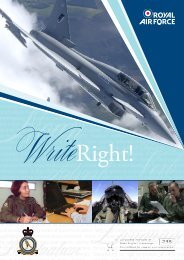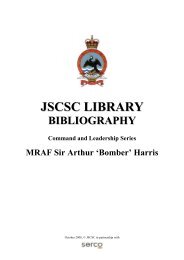The Russian Federation Navy: An Assessment of its Strategic ...
The Russian Federation Navy: An Assessment of its Strategic ...
The Russian Federation Navy: An Assessment of its Strategic ...
You also want an ePaper? Increase the reach of your titles
YUMPU automatically turns print PDFs into web optimized ePapers that Google loves.
mobilization readiness; strategic mobility; a high strength level in well-trained and wellpreparedpersonnel, including enlistees; [and] high level <strong>of</strong> equipment and resources’. 47<strong>The</strong> military modernisation is intended to substantively transform the posture, capabilitiesand outlook <strong>of</strong> the <strong>Russian</strong> Armed Forces; President Medvedev stated the objective as beingto provide ‘a qualitative modernisation <strong>of</strong> our Armed Forces to give them a new, forwardlookingperspective’. 48 A major element <strong>of</strong> this is a shift in strategy from that <strong>of</strong> a groundcomponent-centric force to one emphasising air-and-space and maritime forces deliveringlong-range precision-guided munitions. 49 This is intended to enable the attainment <strong>of</strong>objectives by the application <strong>of</strong> ‘fire for effect’; or via:effective selective strikes onto a small number <strong>of</strong> “strategically significant” or“vitally valuable” objects <strong>of</strong> an enemy, discontinued or infringed function <strong>of</strong> whichcan lead to impossibility <strong>of</strong> continuation <strong>of</strong> aggression or will “catastrophically”reduce efficiency <strong>of</strong> use <strong>of</strong> <strong>its</strong> combat weapons. 50This is a component <strong>of</strong> Russia’s de-escalation concept whereby the application <strong>of</strong> forceagainst strategically vital targets can serve the ‘purpose <strong>of</strong> compulsion <strong>of</strong> the enemy toterminate immediately military aggression’. 51 <strong>The</strong> Priority Tasks <strong>of</strong> the Development <strong>of</strong> theArmed Forces <strong>of</strong> the <strong>Russian</strong> <strong>Federation</strong> states that ‘Special significance is attached toprompt disablement <strong>of</strong> the opponent’s infrastructure concerned with political and economicmanagement, and <strong>its</strong> systems <strong>of</strong> communication...’ It also suggests that traditional concepts<strong>of</strong> concentrating manpower and equipment needs dispensing with and replaced by‘dominating manoeuvre’ whereby the adversary is defeated via the concentration <strong>of</strong> effortsthrough manoeuvre and the application <strong>of</strong> ‘massive fire strikes’ rather than mass. 52 Inaddition, the first priority in armed conflict has shifted from attaining a physical advantage tothat <strong>of</strong> attaining supremacy in the information sphere; that is, ‘gaining the dominatinginfluence in the public mind and in troop and arms control’. 53Further, there is an increasing interest in the application <strong>of</strong> force as a means <strong>of</strong> influencingthe behaviour <strong>of</strong> an adversary or coalition. This was highlighted by the then Commander-in-Chief <strong>of</strong> the <strong>Russian</strong> <strong>Navy</strong>, Admiral Vladimir Masorin:• interdependence <strong>of</strong> national economies at the world level that makes itpossible, by affecting the economy <strong>of</strong> one or several countries, to trigger <strong>of</strong>funacceptable economic vacillations or crises in the entire coalition <strong>of</strong>potential adversaries; ... [and]• high dependence <strong>of</strong> the economies <strong>of</strong> the industrially advanced countries onan uninterrupted functioning <strong>of</strong> their energy supply and transport systems,something that makes it possible to regard elements <strong>of</strong> those systems as thekey objects for influencing the economies <strong>of</strong> the potential adversaries. 54<strong>The</strong> evolving conceptual basis <strong>of</strong> the <strong>Russian</strong> Armed Forces is a component <strong>of</strong> a wider shiftin the posture and physical focus <strong>of</strong> the military. This is especially so with regard to therelative importance <strong>of</strong> the three services, that is, an increasing prominence for the Air Force47 Rukshin, ‘Doctrinal Views on Employment and Organizational Development <strong>of</strong> the Armed Forces <strong>of</strong> Russia’.48 Speech at an Extended Session <strong>of</strong> the Defence Ministry Board, 17 March 2009.49 <strong>The</strong> Priority Tasks <strong>of</strong> the Development <strong>of</strong> the Armed Forces <strong>of</strong> the <strong>Russian</strong> <strong>Federation</strong>.50 Colonel M V Fomin, ‘Formation <strong>of</strong> a Rational System <strong>of</strong> Weapons <strong>of</strong> Long-Range Aviation’. MilitaryThought, No. 2, 2007.51 Ibid.52 <strong>The</strong> Priority Tasks <strong>of</strong> the development <strong>of</strong> the Armed Forces <strong>of</strong> the <strong>Russian</strong> <strong>Federation</strong>, p. 59.53 Ibid.54 Admiral Vladimir Masorin, ‘Naval Doctrine as a Component Part <strong>of</strong> the <strong>Russian</strong> <strong>Federation</strong> MilitaryDoctrine’, Military Thought, No. 2, 2007.8



